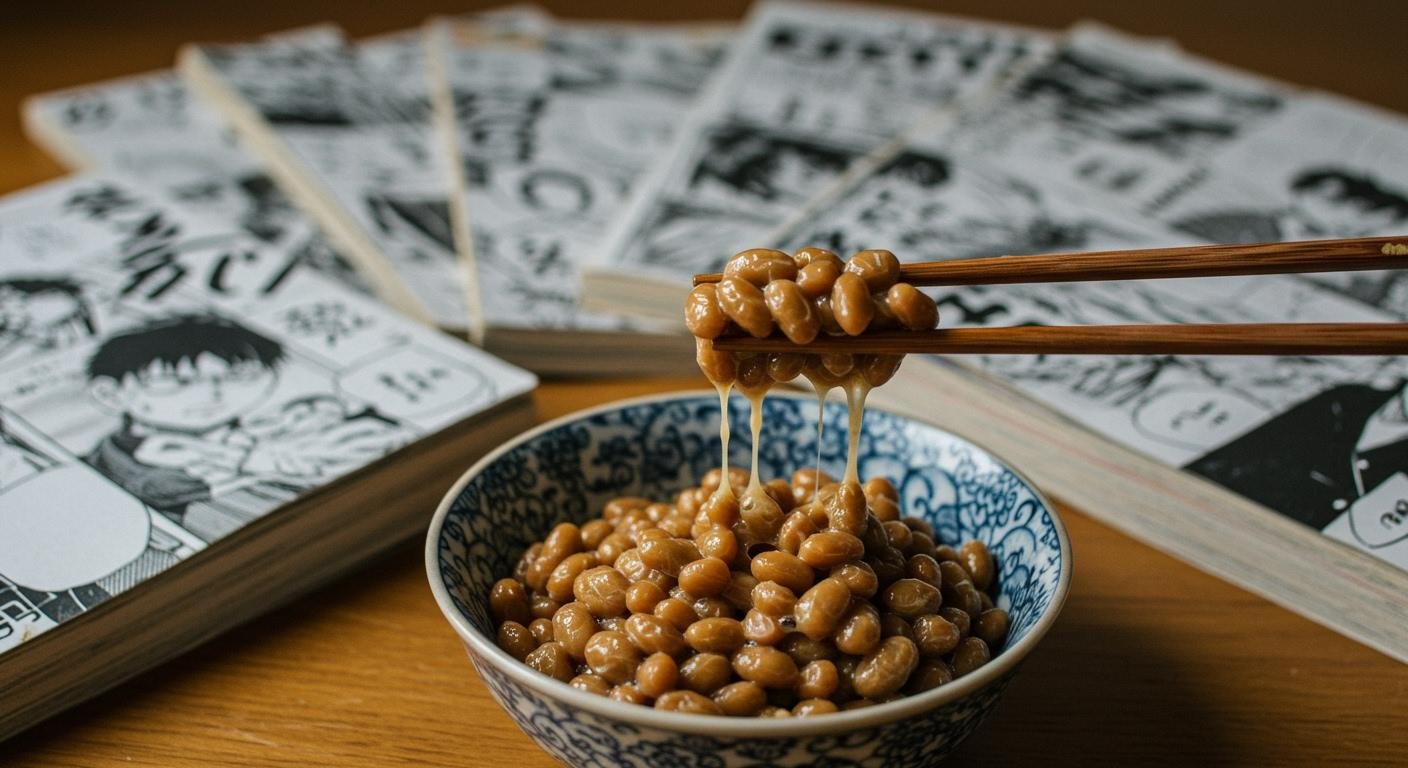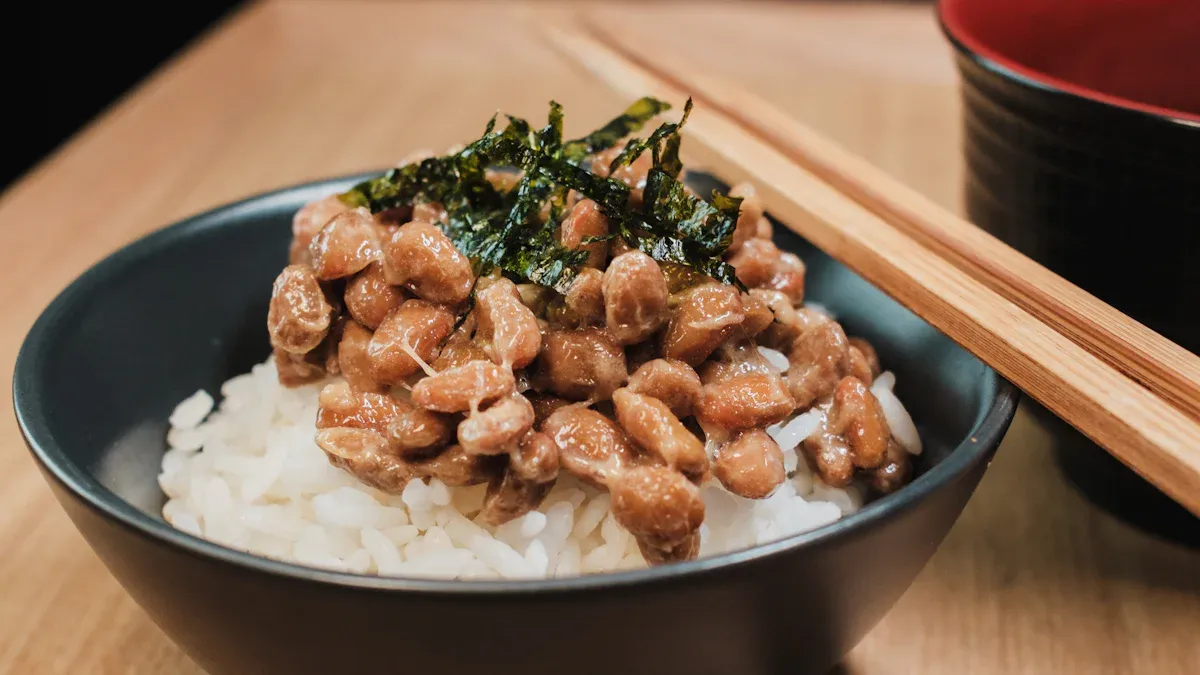Why Natto Keeps Appearing in Popular Manga
Table of Contents

Ever wonder why that sticky, stringy natto keeps popping up in your favorite popular manga? 🤔 Manga creators use natto as a powerful cultural shorthand. A character’s reaction to it instantly reveals their personality or establishes a traditional setting in Japan. This use of natto as a symbol of Japanese culture extends beyond manga. For instance, in the TV drama Shōgun, the protagonist’s willingness to try natto shows his acceptance of new customs.
The FX series Shogun features natto, where the character John Blackthorne, an English pilot, is encouraged to eat it. Initially hesitant due to its sticky appearance, he eventually tries and enjoys it. This act is presented as an example of Blackthorne embracing Japanese culture, symbolizing his assimilation.
Decoding what natto means in manga unlocks a hidden layer of storytelling.
CHARACTER TRAITS IN POPULAR MANGA
A character’s lunchbox can tell you more than their favorite food. In manga, a simple serving of natto is a masterclass in character development. Creators use a character’s reaction to the sticky soybeans to instantly signal who they are.
THE TRADITIONALIST
Does a character happily whip up a bowl of natto for breakfast? This is a classic sign of a “Traditionalist.” These characters are often portrayed as humble, down-to-earth, and connected to the simple traditions of Japan. They are not impressed by fancy or expensive things. They find comfort in the familiar.
A perfect example is Gintoki Sakata from the popular manga Gintama. He is a powerful samurai living a lazy, everyday life. The anime frequently shows him eating natto over rice. This simple meal choice grounds his character. It shows he is just a regular guy despite his heroic past. The manga Silver Spoon also uses this trope. Its characters live in a farming community, so their love for natto highlights their appreciation for traditional, homegrown food. The anime adaptation beautifully visualizes these simple, hearty meals.
THE OUTSIDER
On the flip side, a character who gags at the sight or smell of natto is immediately marked as an “Outsider.” This reaction is a quick way for a manga to communicate several traits.
- Regional Differences: Natto is a staple in eastern Japan (Kanto region), but less common in the west (Kansai region). A character from Osaka showing disgust for natto is a classic, relatable joke. It instantly establishes their origins and creates funny conflict with their Tokyo friends.
- Picky or Refined: A character who rejects natto might be shown as picky, spoiled, or having “high-class” tastes. They prefer fancy pastries over fermented soybeans. This is a common trope in many anime series.
- Foreigner: Like John Blackthorne in Shōgun, a character new to Japan will almost always have a dramatic first encounter with natto. Their reaction is a test of their open-mindedness.
Did You Know? The yōkai Nattō Kozō, who appears in the best-selling manga Nurarihyon no Mago, is a literal embodiment of this food. He is a small, child-like spirit who carries a bowl of natto. His appearance in the manga and anime is a fun nod to this iconic part of Japanese folklore. For anime fans, seeing this character is a great cultural inside joke.
Whether a character loves or hates it, their feeling about natto is rarely an accident in any given anime. It’s a deliberate choice by the creator to add a quick and effective layer of personality.
A SYMBOL OF JAPANESE LIFE

Beyond defining a character, natto grounds a story in everyday Japan. Its presence is a powerful tool for world-building, instantly communicating a sense of place and cultural norms. A simple bowl of beans can set an entire scene.
THE BREAKFAST SCENE
Manga creators often use natto to establish a normal household setting. A panel showing a character eating natto with rice and miso soup is a visual shortcut. It immediately signals a traditional japanese breakfast. This simple meal reinforces a feeling of normalcy and routine. It tells the audience that the story is happening in a typical home in Japan. This technique is common in slice-of-life manga, where daily routines are central to the plot.
THE CULTURAL INSIDE JOKE
The “love it or hate it” nature of natto is a famous part of life in Japan. Manga creators use this for great comedic effect. A character’s dramatic reaction to natto is a relatable inside joke. This shared experience can create funny conflicts or moments of bonding between characters.
Pro Tip: The debate over how many times to stir natto is a real social media trend in Japan! Some swear by 50 stirs, while others go for over 400 to achieve the perfect texture. A manga might show a character meticulously stirring their natto, adding another layer of authentic humor.
A STAPLE IN FOOD MANGA
Natto is a star ingredient in food manga. Series like the classic manga Oishinbo and the popular manga Shokugeki no Soma (also known as Food Wars!) frequently feature it. These stories explore the culinary potential of natto beyond the breakfast bowl. The challenge of cooking with such a distinct ingredient makes for exciting plot points in any food manga. Oishinbo often uses natto in its cooking battles.
In Yakitate!! Ja-pan, the protagonist’s journey begins with a challenge involving natto. He must create a bread that perfectly complements it, showing how central the food is. The creative cooking in a food manga like Oishinbo is legendary. Likewise, the cooking in Food Wars! is always over-the-top. The chefs in Shokugeki no Soma transform natto into gourmet dishes. Ryōko Sakaki, a fermentation expert in the manga, showcases her cooking skill with this unique dish. The creative cooking in Oishinbo is a key part of its appeal, and the same is true for any good food manga. The cooking in Oishinbo is a masterclass, and other food manga like Shokugeki no Soma follow its lead. The world of food manga, especially Oishinbo, loves a good cooking challenge.
| Dish Name | Primary Ingredients | Chef | Manga Debut | Anime Debut |
|---|---|---|---|---|
| Curry Soy-Natto Rice | Charcoal-burned Natto, Soy-Sauce Shiokōji | Ryōko Sakaki | Chapter 54 | Episode 23 |
The cooking in Oishinbo and other food manga shows that even simple ingredients can become amazing meals.
A DEVICE FOR PLOT AND COMEDY
Natto does more than build worlds or define characters. It often takes center stage as a hilarious prop or a powerful plot device. Its unique physical properties and nutritional value make it a versatile tool for any manga creator looking to add some fun or drama.
STICKY SLAPSTICK
Natto’s most famous feature is its incredible stickiness. This quality is a goldmine for physical comedy. Artists love to exaggerate its stringy texture for maximum comedic effect. A simple meal can quickly turn into a chaotic, sticky mess.
Manga artists often use visual gags to show this:
- They draw natto with impossibly long and stretchy strings.
- The strings sometimes stretch across multiple panels or even off the page.
- Characters get tangled in the gooey strands, leading to hilarious struggles.
The manga Sabagebu! uses this for a classic gag. Momoka forces her teammate Maya to undergo “Training from Hell” to overcome her dislike of natto. The goal was to prepare Maya for a natto commercial. In a funny twist, Maya never does the commercial. Momoka ends up doing it instead, making the entire sticky training session a pointless and comedic ordeal.
THE SUPERFOOD BOOST
Sometimes, natto is no joke. It is a legitimate superfood. A character eating natto can signal they are about to get a serious power-up. This trope uses natto’s real-life health benefits to advance the plot. A bowl of fermented soybeans can be the secret weapon for a training arc or a pre-battle meal.
Natto Power! 🔋 Natto is packed with protein, fiber, and essential vitamins like Vitamin K2, which is great for bone health. It also contains a special enzyme called nattokinase. This enzyme is studied for its ability to improve heart health. This makes natto the perfect food for a manga hero needing a quick and healthy boost.
This use of natto shows a character’s dedication. They are willing to eat the challenging food to gain an edge. It’s a simple way to show their commitment to getting stronger, turning a humble breakfast into a source of incredible power.
Natto in manga is a secret weapon for creators. It defines characters, builds an authentic vision of Japan, and creates hilarious situations. A simple bowl of beans carries so much meaning in any manga.
A creator uses natto as a clever symbol. It is more than just food; it is a storytelling shortcut that leverages the culture of Japan.
Now you know the secret! The next time you see natto in a popular manga, you will understand its true meaning. 😉
FAQ
What is natto, exactly?
Natto is a traditional Japanese food. It consists of fermented soybeans. People know it for its powerful smell and very sticky, stringy texture. It is a unique and famous dish. 🥢
Why is stirring natto a big deal in manga?
Manga creators use the stirring debate for comedy. Many people in Japan believe stirring natto many times improves its flavor. A character’s intense stirring method is a funny, relatable detail for Japanese readers. It shows their quirky personality.
Do all Japanese people really eat natto?
No, natto is a divisive food! Its popularity varies by region. People in eastern Japan (Kanto) eat it often. People in western Japan (Kansai) are less likely to enjoy it. This regional split creates great character conflict.
Is natto as popular in real life as in manga?
Yes, it is a true staple! Natto is a very common breakfast food in many Japanese homes. You can find it in every convenience store and supermarket. Its frequent appearance in manga reflects its real-life importance. 🍱

Poseidon
Master of Nutritional Epidemiology, University of Copenhagen, Herbal Functional Nutrition Researcher
Focus: The scientific application of natural active ingredients such as Tongo Ali, Horny Goat Weed, and Maca to sexual health and metabolic regulation.
Core Focus:
Men: Use a combination of Tongo Ali (an energizing factor) + Maca (an energy reserve) to improve low energy and fluctuating libido.
Women: Use a combination of Horny Goat Weed (a gentle regulator) + Maca (a nutritional synergist) to alleviate low libido and hormonal imbalances.
Stressed/Middle-Aged Adults: This triple-ingredient synergy supports metabolism, physical strength, and intimacy.
Product Concept:
Based on traditional applications and modern research (e.g., Tongo Ali promotes testosterone-enhancing enzyme activity, and icariin provides gentle regulation), we preserve core active ingredients and eschew conceptual packaging—using natural ingredients to address specific needs.
Simply put: I'm a nutritionist who understands "herbal actives." I use scientifically proven ingredients like Tongo Ali, Epimedium, and Maca to help you make "sexual health" and "nutritional support" a daily routine.
